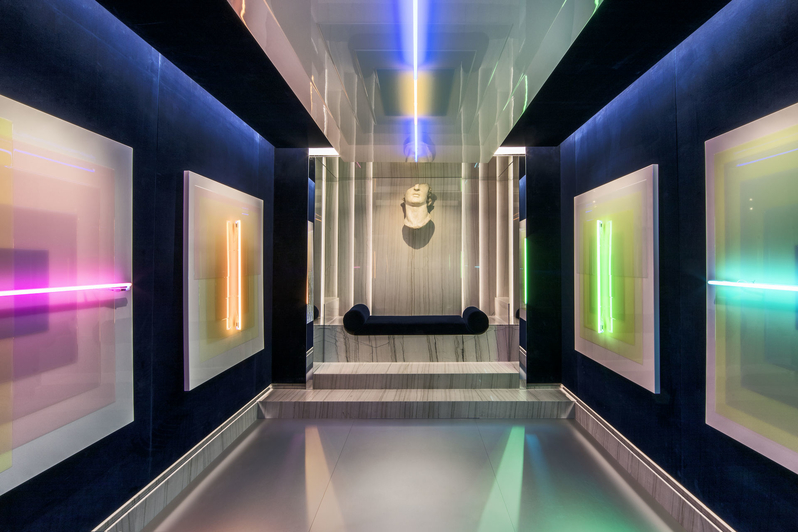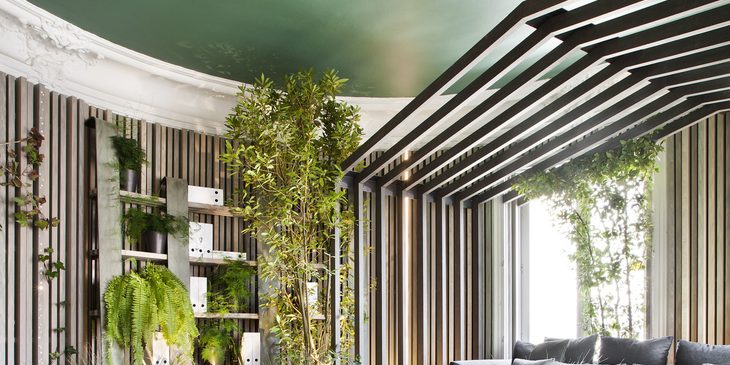INSPIRATION
FIVE DESIGN TRENDS WE'LL BE SEEING IN THE NEAR FUTURE
Designers and architects across the globe consult their crystal balls
Architects and designers have long mused about what the future would hold. In the 1930s, French architect Le Corbusier famously imagined a Radiant City where efficient, concrete block housing was brought to life with thoughtfully cultivated green space. After World War II, American architect Buckminster Fuller imagined people living in inexpensive, mass-producible homes like his portable Dymaxion House, designed to reduce water consumption—it could be shipped to the homeowner in a metal tube. And through the middle of the 20th century, Americans Charles and Ray Eames designed for a world in which furniture was simple, long-lasting, and affordable, in line with their famous ethos to “make the best for the most for the least.” Looking forward has always been part of the job.
So, as the globe’s tectonic plates rapidly shift beneath us once again, we asked some of today’s creatives what they see in the future. Their answers range from the practical (less waste, more modular furniture) to the conceptual (more diverse design narratives, deeper relationships with our things). But one thought rang through the bunch: We must question the accepted way of doing things. We must change. Lighting designer Bec Brittain prefers questions to answers. One that’s at the top of her mind: “If we’re simply making beautiful things, what is our social obligation?” Here are nine predictions that creatives are looking forward to.

1. A less Eurocentric design narrative
As the Western world reckons with its racist past and present, creatives predict a recentering of more diverse design narratives. Palaash Chaudhary and Utharaa Zacharias of the San Jose–based firm Soft-Geometry envision “a slow start to redefining what is a desirable aesthetic in design and diversifying it from a singular Eurocentric visual narrative. BIPOC designers, like us, can be more fearless in looking to our own cultures and histories for aesthetic inspiration and influence.” Evan Jerry of London-based Studio Anansi echoes this sentiment, noting the design world’s recent “awakening” to the lack of representation Black designers have long faced. “This interruption of the design industry’s established aesthetics forces it to expand to include a multitude of narratives and perspectives that are relatable to more people,” he explains. “More female perspectives, more queer and trans perspectives, more perspectives from people with disabilities, more Black perspectives. I imagine a design future that focuses on many individual narratives, rather than a single one.” Gabriel Hendifar of New York–based lighting brand Apparatus agrees: “I hope for more people from a broader range of backgrounds to be able to tell their stories in ways that are celebrated and uplifted. I hope that seeing those stories will broaden our ideas about what it means to live well.”
New York designer Robert Sukrachand has considered representation as well. His prediction: “Major design companies and small studios will be forced to confront the stark reality of a white-dominated industry. If this representational problem is addressed we will see a renaissance of creative output. An embrace and full engagement of those voices will result in a design community with an enriched soul. A massive segment of the buying public whose needs have been neglected will start to be addressed. We will lose taste for the caricatures of ‘global chic’ and grow into more complex, unhomogenized relationships with designs from across the world. Most importantly, design will be stripped of its narrow capitalist definition and be seen for what it truly is: a political tool.”


2. Craft and technology working hand in hand
Artist and designer Atang Tshikare, who is established in Cape Town, envisions a fourth industrial revolution, where technology simplifies manufacturing, and what was once considered genius or rare will become an everyday offering. In this world, he imagines “handmade and ancient methods of creating will become sought after. Artists will collaborate with tech specialists so that they can extend and amend their output, and artistic freedom will be relative because human rights are becoming more regulated. A prime example of this sort of design-meets-tech is the new Yeezy foam runner, where an artist is creating clothing that sells out within hours.”
3. More flexible furniture
As many of us shifted every aspect of our lives—work, school, the gym, leisure—into our homes, our furnishings have had to perform tasks we never imagined. As a result, L.A.-based designer Leah Ring says, “the importance of a comfortable and flexible home and working environment has become paramount.” She forecasts that more flexible furniture—indoor/outdoor furniture, a desk that converts into a dining table, modular seating that can be assembled to create a sofa and disassembled to allow for socially distanced seating, and so on—will continue to rise in popularity.
4. Nature takeover
After months confined to our own homes, we can’t overestimate the importance of green space. Designers predict that plants—whether a fire escape garden or a lush backyard—will factor more heavily into residential design. “Connection to the outdoors is an element of life that is shifting rapidly,” says New York landscape architect Sara Zewde, “from the small adaptations we’ve made in our homes and daily lives, to the large-scale retrofitting of parks, streets, and plazas to accommodate everything from field hospitals to outdoor dining. These shifts may signal an ongoing movement toward reorienting ourselves to the outside, and thus to each other, well into the future.”
But getting in touch with nature isn’t simply about having more plants around. New York–based architect Serban Ionescu elaborates: “Too many sustainable designs carry the same straight lines and boxes we see everywhere that are mediocre and disconnected from the free forms of nature. Nature does not express itself in straight lines. Nature is emotional and unpredictable. Green is wild, jagged, irregular, curved; it’s underground and mysterious. It has bugs and sometimes it’s scary and aesthetically unpleasing. I think the future holds a scary wild side for design.”
5. Less waste
In Serban’s vision, the materials of the future are, first and foremost, sustainable. They are materials we already have—upcycled, repaired, and resurrected as new. “No more of all the plastic stuff that breaks constantly and needs to be replaced every year,” he says. “We need to either make compostable single-use things or long-lasting objects of importance and soul.”



